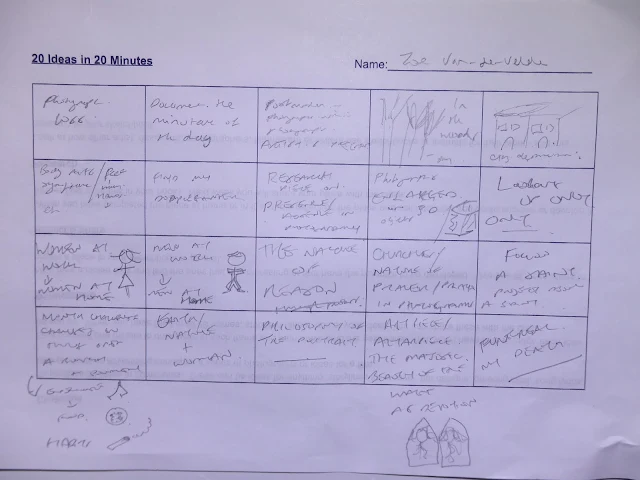Welcome to the new term - This post will show you the ideas that I have generated and started to explore for a new project.
The beginning of this first journey starts with 20 ideas in 20 minutes

From this exercise I I have generated a wide variety of photographic
project ideas the ones that I liked particularly are:
- Creating an Art
Piece/Altarpiece that explores the majestic nature of iconic images and
how they become devotional objects
- A research piece on the
philosophy of the portrait
- Documenting change over a
month - a personal change in habits, lifestyle etc and the effects.
- Photographs enlarged and
used as a part of a 3D Installation on physical objects
I will begin by looking into these idea and researching others work to
explore whether I can create an original piece that has new perspective of
technique.
Rejected Altarpieces:
Caravaggio
Michelangelo Merisi da Caravaggio
Inspiration of Saint Matthew(first version), c.1602
Oil on canvas, 223x183cm
[destroyed in World War II]
Caravaggio used realism and naturalism and this was considered by the
church not in keeping with the elevation of Saints and Religious icons such as
this image above. This image was considered not in keeping with the evangelical spirit that was acceptable in this period. The 17th Century Critic
Bellori stated: 'the figure had neither the decorum nor the aspect of a
saint, being seated with his legs crossed and his feet crudely exposed to the
public.'[1]
I chose this image for reflection as it has a photographic aspect in
that as a black and white photograph this would be very similar. The hands and
the feet are the most prominent areas in the image and it is with our hands
that we pray and reach out to worship, to touch others, to show love or
hate. Our feet keep us upright, keep us moving and the appearance of bare
feet show a connection not just to God but to the earth and earthly things.
I will consider some photograph in response to this image to reflect
more on the aspects of this composition and the meaning of the symbols
incorporated.
Also here I would like to explore this piece The Death of the Virgin by
Caravaggio:
Death of the Virgin
Italian: Morte della vergine, Italian: Transito
della Madonna 1604-1606
Above: Caravaggio, Death of the Virgin,
1605-6, Louvre (detail)
This piece was heavily criticised again at the time as the critic
Haarlem Van Mander stated that the model for the Virgin was; “one or other
filthy whore” Again the realism and naturalness of the people depicted did not
conform to the majestic evangelic images that were acceptable in a house of God
at this time.
The hands in this image are the expression of feeling as the virgin's
hand rests upon her stomach in death and her other hand hangs languidly over
the bed. Her face is not a perfect vision but one with expression and
lines that reflect all too human qualities, Again the bare feet connect
the participants of the scene to the earth.
References
Alstrom Apprasails LLC (2018) Mild applause: Caravaggio's
Rejected Altarpieces [Online] Available from:
http://ahlstromappraisals.com/art-history-blog/mild-applause-caravaggio
(Accessed 6th July 2018)
Art Histories Room (5th January 2014)) Hendrick ter Brugghen and
the “ugly” Christ Child
https://arthistoriesroom.wordpress.com/2014/01/05/hendrick-ter-brugghen-and-the-ugly-christ-child/
(Accessed 6th July 2018)






















